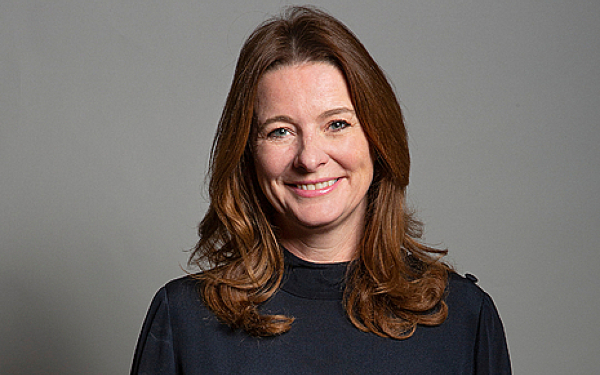
The government’s care funding reforms will do very little for those with longstanding needs and modest wealth, following changes that reduce their benefit for the less well-off.
That was the warning today from Andrew Dilnot, whose commission devised the blueprint for the cap on care costs that the government will bring in from 2023, after the changes announced yesterday by care minister Gillian Keegan.
She said that, for people receiving means-tested support from their local authority, only what they pay in care charges will contribute to the £86,000 cap.
This is contrary to the system currently legislated for, but not yet implemented, in the Care Act 2014, and that proposed in 2011 by the Dilnot commission. Under this, what would have counted towards the cap would be the person’s client contributions plus whatever their local authority spends on their care, excluding care home living costs.
The change, which was not revealed when the government unveiled its reform plans in September, will mean that people with lower levels of assets will need to spend the same as wealthier people before reaching the cap, after which care and support is free apart from care home living costs.
Vote on Care Act change
MPs will vote on the change to the Care Act next week in a government amendment to the current Health and Social Care Bill, which should succeed given its working majority of 77.
In a written statement to Parliament yesterday, Keegan said: “This change will reduce complexity; it will ensure individuals receive the support they need through the means test but are not unfairly reaching the cap at an artificially faster rate than what they contribute.”
In an accompanying policy paper, the Department of Health and Social Care said people with lower levels of assets would be helped by changes to the social care means-test, under which those with less than £100,000 in chargeable assets would be eligible for some state support for their care, up from the current upper capital threshold of £23,250. In addition, those with less than £20,000 in assets would not have to contribute to their care from their savings, up from £14,250 now, though this change broadly accounts for the impact of inflation given the freeze in the capital thresholds since 2010.
However, Dilnot, in an apperance today before Parliament’s treasury select committee, joined charities, think-tanks and the Labour Party in criticising the change announced yesterday by Keegan because of its impact on those with lower levels of wealth but high and longstanding care needs.
No benefit for less well off
“Essentially for those who have significant care needs, the less well off will not gain any benefit from the cap. Instead of running your assets down to your last £14,250 you would run them down to your last £20,000. The people who are most harsly affected by this change are people with assets of exactly £106,000, the £86,000 of cap minus the £20,000 that’s protected by the means-tested system. But everyone with assets of less than £186,000 will do less well under what the government is proposing than the proposals that we made…and the proposals legislated for [in the Care Act]. That’s a big change. I think it’s disappointing. It finds savings exclusively from the less well off group.”
Caroline Abrahams, charity director at Age UK, echoed Dilnot’s criticisms, saying that the change the government money “at the cost of protecting the finances of older home owners who are not terribly affluent if they need care for a long time”.
“This feels like completely the wrong policy choice and we are extremely disappointed that the government has made it – and that it is only announcing it now, rather than two months ago when the prime minister set out his plan,” she added.
Sally Warren, director of policy at the King’s Fund, said she too was disappointed by the changes, adding that “the people who need the most protection from catastrophically high care costs – those with low to moderate levels of wealth – will get less protection than wealthier people”.
On Twitter, Torsten Bell, chief executive of fellow think-tank the Resolution Foundation, said: “With the cap’s benefit for those with under £100k of assets much reduced – this techy sounding shift could double your care costs if you’ve got around £90k but makes no difference to someone with £500k who gets almost all their assets protected.
“Just to be clear – the means test will still make a big difference to this group with fewer assets. But if the exam question is whose assets are being protected by this reform, the answer on the basis of this change is much more distinctly the asset rich than previously thought.”
‘Total disgrace’
Labour’s shadow minister for care, Liz Kendall, said the changes were “a total disgrace, but utterly unsurprising”.
“We already knew most people won’t hit the cap because it doesn’t cover board and lodging in care homes, and that at £86,000 the cap would still mean many people will have to sell their homes to pay for their care – against everything Boris Johnson promised,” she added.
“It has now been revealed that the poorest pensioners will have to pay even more, something Andrew Dilnot – who proposed the cap – explicitly ruled out because it was so unfair.
Dilnot said the changes added to several other ways in which the government’s proposals were less generous than those he put forward in 2011:
- His commission put forward a cap of between £25,000 and £50,000, the latter figure being worth £62,000 in today’s money, far lower than the £86,000 cap put forward by ministers.
- While his commission put forward a £100,000 upper capital limit, the same figure is now worth much less because of inflation.
- Dilnot proposed that a zero cap was applied to anyone who acquired care needs before the age of 40 to take account of their reduced ability to earn during their lifetime, however, the government is applying the same cap to all, penalising working-age adults with care needs.
‘Everyone is better off’
However, he pointed out that, in some respects, the government’s plans were more generous than either those he proposed or those which the then government put forward in 2015 when it had planned to implement the change before dropping it in 2016. For one, his proposed changes to the means-test would not have applied to people receiving care in their own home, who would benefit from the government’s plans.
And the 2015 proposals would have required people in care homes to pay £230 per week towards their daily living costs after reaching the cap, while this sum would also not count towards the cap for any resident before they reached it.
However, the government yesterday said it would set a daily living costs sum of £200 per week, which it said would enable people to keep more of their income and assets than was the case in 2015.
A DHSC spokesperson said: “These charging reforms will mean everyone is better off. Compared to the current system more people will be supported with their social care costs, have greater certainty over what they need to pay and receive higher quality care.”





 Bournemouth, Christchurch and Poole
Bournemouth, Christchurch and Poole  Hampshire County Council
Hampshire County Council  Lincolnshire County Council
Lincolnshire County Council  Norfolk County Council
Norfolk County Council  Northamptonshire Children’s Trust
Northamptonshire Children’s Trust  South Gloucestershire Council
South Gloucestershire Council  Wiltshire Council
Wiltshire Council  Wokingham Borough Council
Wokingham Borough Council  Children and young people with SEND are ‘valued and prioritised’ in Wiltshire, find inspectors
Children and young people with SEND are ‘valued and prioritised’ in Wiltshire, find inspectors  How specialist refugee teams benefit young people and social workers
How specialist refugee teams benefit young people and social workers  Podcast: returning to social work after becoming a first-time parent
Podcast: returning to social work after becoming a first-time parent  Podcast: would you work for an inadequate-rated service?
Podcast: would you work for an inadequate-rated service?  Family help: one local authority’s experience of the model
Family help: one local authority’s experience of the model  Workforce Insights – showcasing a selection of the sector’s top recruiters
Workforce Insights – showcasing a selection of the sector’s top recruiters 

 Facebook
Facebook X
X LinkedIn
LinkedIn Instagram
Instagram
Yes levelling up in action. This was always about protecting the assets of little Tabitha & Rupert from having their inheritance wiped out by unlimited liability. Those with assets worth half a million+ Tory Southern voters will be protected. The hatred of this Government of Northern people finds expression at every level of Social Policy. Many people in Northern areas where house prices are relatively low will still have nearly all of their estate taken by the state to pay care costs. All of this would be more acceptable if they provided good Education, Housing and good public services for the children of the above, but they don’t do they. They want it all and your children can sleep in the park. My hatred of the Tories equals their hatred of Northern people.
The cap will benefit everyone who have expensive care needs in their old age and place more on tax payers to cover the cost. Those with more expensive houses surely are those who pay more in tax and in addition the freezing of the threshold at which you pay inheritance tax also means that there is an additional stealth tax on the wealthier.
When you look at the whole picture and not just a part if it in isolation the approach is more progressive than is made out in my opinion.
This is more complicated than it looks. There’s a danger of confusing two separate issues, about which it’s possible to have entirely different views. One issue is whether additional funding should be focused on protecting inheritances or on reducing the financial impact of charges on the large proportion of current service users who have low incomes and limited assets; the other issue is what the best *mechanism* would be if the aim was to give more protection to people who pay income-based charges (who have in many areas been paying an increasing proportion of their income in charges since the Care Act, in part because of the freezing of the minimum income guarantee for service users in the community and of the personal expenses allowance in care homes).
The Dilnot *mechanism* for supporting people who don’t have substantial savings or property was a bad way to achieve its objective, and the annoucement that that mechanism won’t be implemented should be welcomed. It would have had some seriously perverse consequences, such as penalising people whose families provide a substantial proportion of the care a person needs, who would accumulate less in their care accounts even if they were paying the same charges. A fairer and simpler way to spread the benefits of new funding would be to make the *income*-based means test more generous. There’s no good reason to campaign to keep the Care Act mechanism, which looked good on a spreadsheet but would have had nonsensical consequences in practice.
In his Open University documentary on care in the community and in care homes on BBC TV earlier this week it was interesting to listen to the former Secretary of Sate for Health and Social Care and Chancellor of the Exchequer, Ed Balls pleading that the current and future Governments in the UK must spend an additional £10 billion a year on the sector whilst his wife, and current Chair of a House of Commons committee, Yvette Cooper telling him that it ain’t going to happen. From Ed’s comments you would not have thought that he used to be a senior British Cabinet Minister with responsibility for this situation……
Next they will be spinning coal as green energy and telling the homeless that sleeping in the park will build character. Will all those that think the Tories care please leave this chat room.
How about we cost share through general tax the risks associated with growing older and being asset stripped by the state. Just a thought.
The original Care Act proposals only ever intended for the individual’s contributions to be counted – hence the Care Accounts we all planned for back in 2014 / 15 that never materialised. The new proposals were very similar with higher caps but why would you include local authority contributions? It will be interesting to see whether care homes equalise fees between those who are private or state funded – there are plenty of good care homes who take local authority rates – it is the larger firms who take high fees and vast profits to pay their shareholders ……
In terms of North / South divide – yes people may have less in property assets in the North but they also probably paid considerably less for their houses and had lower mortgage costs over many years.
The main gap for me is the continued disparity in Continuing Care and social care across the country where you can be eligible in areas of the country for CHC but not in others depending on how CCGs interpret the guidance. It would have been better to have a National care service with clearer eligibility criteria and corresponding services for all
In all of these calculations, where is the costs of administering such arrangements, as opposed to putting Social Care on the same basis as for health care.
Why should some with certain conditions have to pay when for people with other conditions do not, this is a conditions lottery and is discriminatory.